Want to know how to write a headline that’ll convert like gangbusters?
Need a headline game-changer that captivates readers?
Your marketing buddies leverage some surefire number psychology and pricing tactics to attract their targeted consumers.
Why can’t you do the same?
Let’s shamelessly borrow a page or two from their playbook to ramp up the magnetism of your own headlines!
We’ll start with the obvious question…
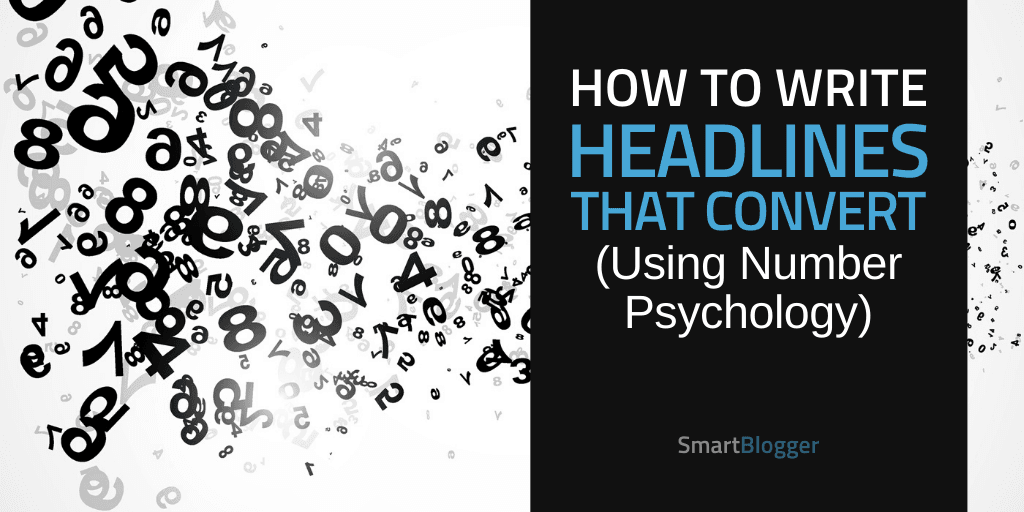
Why Do Numbers Make Delicious Marketing Candy?
Chances are, you’ve fallen victim to psychological pricing tactics.
“Charm pricing” uses number psychology to influence our brains to perceive that $19.99 is considerably less than $20.00. It’s so simple, it shouldn’t work. But it does.
Marketers use psychological pricing tactics like these because they know numbers are powerful communication tools. Smart copywriters, bloggers, and SEO experts know this too — which is why they use tactics drawn from number psychology studies to influence headline click-through rates.
But why are numbers so powerful?
Psychology and marketing researcher Nick Kolenda says that when we see a number, our brain triggers the foundation of sensory elements that we used to learn numbers.
Curiously, this foundation often distorts our perception of numbers:
In content marketing, it makes sense to understand why readers are so attracted to numbers and what specific numbers draw greater attention.
In 5 Reasons Why Using Numbers In Your Headlines Work, Mike Hamers explains that numbers are our “Brain Candy”:
“Our brains are attracted to numbers because they automatically organize information into a logical order… like candy for your organizational mind.”
Further, the science of targeted number selection can have an impact on your headlines’ conversion rates.
In Psychology: How to Effectively Use Numbers in Your Marketing, the Wix Team states:
“Like colors, numbers have their own psychology surrounding them. …knowing the meaning behind numbers can allow you to effectively apply them…”
So, that’s why numbers are so effective…
Now let’s go over how you can use them to supercharge your own headlines.
Numbers: Power Words for the Nonconscious Brain
Want a proven blueprint for crafting compelling headlines?
Start by using a headline formula or template built around the keyword you’re targeting. Then, artfully select and arrange persuasive power words to promote your article’s message while catering to the demands of search engines and your readers.
In short, click-worthy headlines:
- include the primary keyword, and
- demonstrate a benefit to the reader
Primary keywords are pretty straightforward to work into your headlines, but it’s trickier to satisfy our readers’ WIIFM (what’s in it for me) mindset. Which is a shame, because being able to express your content’s benefit to the reader is what turns good headlines into great headlines.
Breaking them down, benefits can be expressed in headlines either explicitly or implicitly:
- Explicit benefit headlines lay it all out for you. These are obvious: “How to Eat a Paleo Breakfast”.
- Implicit or implied benefit headlines take some nonconscious noodling to interpret. “Breakfast Blunders Paleo Newbies Get Wrong” hints that we’ll benefit by avoiding bad choices.
So, where does number psychology come into this headline writing gameplan?
Let’s take a look at how we can add numbers to our best headlines to amplify our readers’ perception of benefits.
1. Big or Small: Pick a Number That’s Just Right for the Job
You can write compelling headlines that strengthen the appeal of a benefit by implying additional benefits through the use of numbers. Example:
Today’s Healthy Breakfast: 4 Ingredient Zucchini Fritters
The explicit benefit expressed here is a new healthy breakfast recipe.
But wait, there’s more! Did you notice the hidden bonus benefit that’s implied?
That small number of ingredients impacts your impression of the benefit. Instantly, you anticipate a new, healthy, and easy breakfast recipe. [CLICK!]
Why does this work?
Numbers are adjectives. But instead of the actual value they represent, we tend to interpret numbers in headlines to suggest the relative nature or size of the noun it describes.
Huh? Is this a grammar lesson?
I’ll explain…
This headline’s implied benefit doesn’t change much if the number of ingredients changes to either 3 or 5. The relatively low value emphasizes that the recipe is easy. But, raise the number to 7 and the implied simplicity of the recipe slips away.
We are especially likely to over-infer quantity when asked to make a difficult, concurrent, or snap judgment, like when we’re scanning different headlines.
Take a look at Neil Patel’s catchy headline:
Neil emphasizes the implied “wearing t-shirts prevents you from making money” with a sizeable dollar amount, further enticing readers who want to avoid losing sh*t-tons of money!
Numbers in Headlines Tip #1:
Use extremely small or large numbers as exaggerators.
Small numbers can suggest relative simplicity or insignificance. Conversely, large numbers can suggest complexity or substantiality.
Limit the number of steps in “How to” headlines to 9 or fewer to emphasize simplicity.
2. Warning: Watch How You Say it With Numbers
Proceed with caution, though.
Readers’ perception of implied benefits hinges on the correct use of specific time units or the order in which benefits are presented in headlines.
Not All Time is Created Equal
When expressing a concept that’s based in the future, pay attention to how units of time will be perceived.
Small units of time (4 weeks) are perceived as shorter, even when compared to equivalent larger units of time (1 month).
For example, headlines of habit-breaking content should express timelines in days, which is more palatable than the equivalent number of weeks.
Which timeline is more appealing? Compare:
- 21 Days to a Flatter Stomach
- 3 Weeks to a Flatter Stomach
Is “This” Better Than “That”?
Relative value is perceived higher when a larger numerical benefit is presented before a less appealing benefit. We “anchor” our perceptions when the larger benefit is presented first.
Consider this powerful headline on Smart Blogger:
This click-worthy headline is more appealing because the larger traffic-increasing benefit appears before the relatively short time investment.
Numbers in Headlines Tip #2:
When using numbers in headlines to express benefits with time elements or “trade this for that” notions, consider number comparison psychology concepts to assure the reader perceives a positive benefit.
3. No Time Like the Present: Current Year Implications
The current year in headlines implies the bonus benefit of up-to-date information.
Consider the covert power of this little number! It instantly tells the searcher the headline promises timely information inside.
However, if timeliness isn’t relevant, don’t falsely revolutionize your content with a current year headline. Example:
“How to Change a Diaper in 2020”
Unless you’re unveiling something particularly innovative, don’t use the year in the headline.
These headlines reveal we’ll find up-to-date piece of content on Smart Blogger:
- 31 Ways to Find (& Land) Freelance Writing Jobs in 2020
- Affiliate Marketing in 2020: FREE Guide for Beginners
- How to Start a Blog in 2020 (+Resources on EVERYTHING!)
Numbers in Headlines Tip #3:
When timeliness is relevant, include the current year in number form in headlines to reinforce the timeliness of the information within.
Numbers in Headlines: Vanity Brain Candy
Readers are clearly attracted to headlines that demonstrate a benefit to them, but there are other incentives at play.
In addition to demonstrating benefits, we use tactics such as personality, surprise, emotion, or curiosity in our headlines to entice our target audience and appeal to their vanity.
Let’s take a look at how to include numbers in headlines that’ll engage readers’ curiosity and emotions.
4. Popular Numbers Get the Vanity Vote
Quick, what’s your favorite number?
Number psychology tells us that there are common number preferences and number connotations based on gender, group, or cultures. We can leverage these findings by engaging the curiosities and emotions of our targeted readers.
No big surprise, but lucky number 7 is the most popular number used to increase click-through rates in consumer-targeted headlines. Other common favorites are odd single-digit numbers.
Buzzsumo reports that the number 5 draws a higher social media engagement rate in B2B headlines:
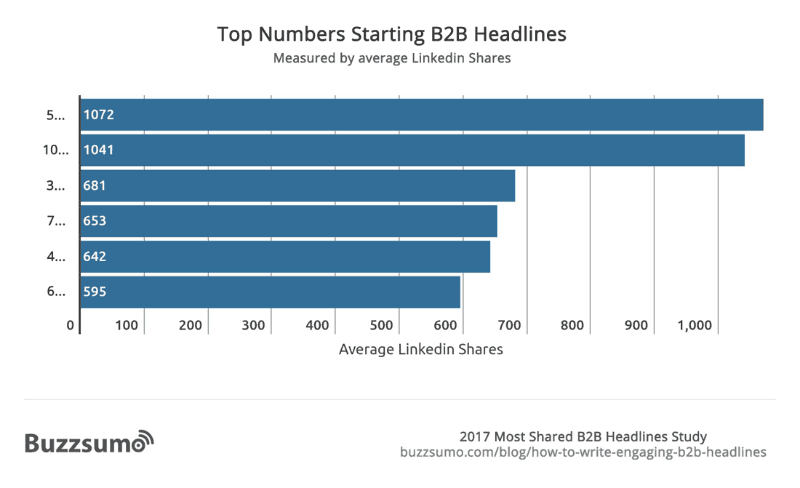
Examples:
- The 5 Best Free Blogging Platforms in 2020 (100% Unbiased)
- How to Make Money Writing: 5 Ways to Get Paid to Write in 2020
Numbers in Headlines Tip #4:
Use common “favorite” numbers in headlines to attract the curiosity of readers in your targeted audience.
5. Odd or Even Pheromones? Numbers to Influences the Sexes
Gender helps us with our perception of the world, so it’s possible the parity of a number (whether even or odd) may influence how our target audience interprets the gender of other parts of a headline.
Studies have shown single-digit odd numbers are perceived by people as masculine, and single-digit even numbers are perceived as feminine.
Men tend to rate double-odd numbers (like 57) and double-even numbers (like 28) as overly masculine, and generally rate most two-digit numbers as masculine as well. Only women consistently rate two-digit even numbers as feminine.
So, how can you apply this information when writing headlines?
Emphasize femininity with even (or double-even) numbers and masculinity with overly masculine double-digit odd (or even) numbers.
Examples:
Numbers in Headlines Tip #5:
Add single-digit odd numbers in headlines to appeal to men and single-digit even numbers to appeal to women. Double-digit even numbers appeal to both sexes, but double-digit odd numbers have greater appeal to men.
6. Why You Shouldn’t Fear Unlucky 13
Triskaidekaphobia is the fear of the number 13, and it’s more common than you’d think.
An estimated 10% of Americans share the fear of the number. Many hotels will actually skip the 13th floor and go right to 14 so they can appease superstitious guests.
The good news? By using the number 13, you can engage a sense of uneasiness or bad luck that’ll make your headline jump off the screen.
Check out these scary headlines:
- 13 Slimy Secrets Your Creepy Boyfriend Hides from You
- 13 Gruesome Horror Movies That’ll Invade Your Sweet Dreams
Numbers in Headlines Tip #6:
Use the number 13 in a headline to elicit a feeling of uneasiness or fear.
7. Why Multiples of 10 are Best for Besties
We are all grounded by the number 10. Our number system is based on tens, which make it easier for us to group things:
- 10 fingers and 10 toes
- 100 pennies makes a dollar
The number 10 symbolizes to us the completion of a cycle, and “10” signifies a perfect score.
Buzzsumo analyzed numbers used in list posts and reported on the popularity, based on the number of social media (Facebook) shares:
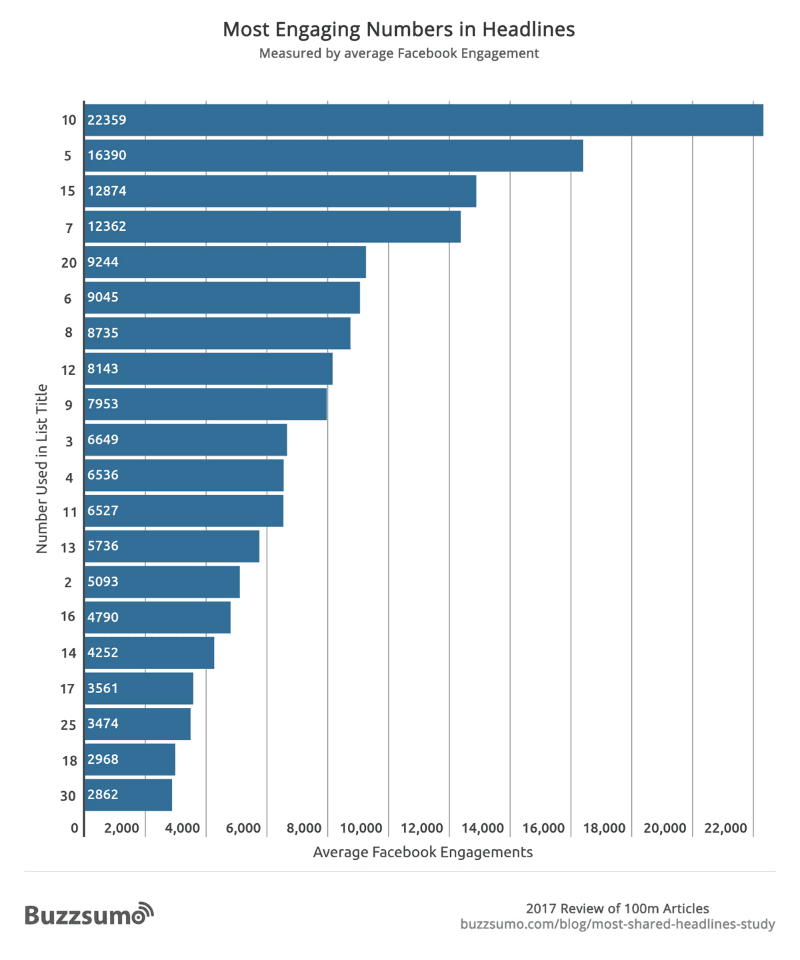
Perfect number 10 is the most engaging number to use with a list post, followed by the number 5 and 15. Our favorite number 7 rounds out the top four numbers used in engaging “listicle” headlines.
Top 10 post headlines like these (with bonus CTR boosters — more on those in a moment) draw us in with neatly compartmentalized topics:
- How to Write Faster: 10 Crafty Ways to Hit 1,000 Words Per Hour
- 10 Posts That’ll Instantly Put You in the Top 1% of Traffic Experts
- This is How 10 Bloggers in Different Niches Make $1 Million+ Per Year
What if you can’t come up with a multiple of 10? Go with an even half!
Check out the nice round numbers in these articles from Forbes:
- 5 B2B Tips and Strategies That You Need to Know in 2019
- 5 Roth IRA Rules You Must Know Before Opening An Account
- Top 5 Writing Tips For Entrepreneurs
Numbers in Headlines Tip #7:
For the most engaging list post headlines, group items in multiples of 10’s or 5’s.
Throw Out the Rule Book (But Play Fair)
The best headlines are works of art. And sometimes, to create art, you have to be a little unconventional.
Like so:
8. Ignore Grammar Rules (Use Digits Instead of Spelling It Out in Headlines)
Except for the rare occasion when spelling out a number is more appropriate, take advantage of the click-through-boosting effect of numbers.
Men’s Health wins brownie points for grammar with this headline, but they lose the brain candy game. How would you rewrite this to take advantage of number psychology?
Numbers in Headlines Tip #8
Use symbols like %, $, or digits instead of words to express percentages, dollars, or numbers in headlines.
9. Make a Big Number Sound Even Bigger
What if you want a headline number to sound R-E-A-L-L-Y big?
Readers use a larger amount of mental resources to process numbers with more syllables and falsely infer the magnitude of the number is larger.
A comma in a number changes how it’s pronounced. Compare:
- 1550 = “fifteen fifty” (4 syllables)
- 1,550 = “one thousand, five hundred fifty” (8 syllables)
Numbers in Headlines Tip #9:
Use numbers with more syllables or include comma separators in large headline numbers to increase their phonetic length.
Doing so will influence their perception of magnitude.
10. Promise and Deliver Customer Assurance
Numbers in your headlines can work against you if they’re not supported by your content. Promise “9 Tips for Happiness” and list 7 or 12 in your body copy, you’ll be hung out to dry.
Research for this article uncovered a list post promising, and providing, seven tips on writing headlines. But, the author’s fourth tip is simply a restatement of his first.
Ironically, his fifth tip is: “Trust me: people will check.”
Yup, we did. Busted!
Numbers in Headlines Tip #10:
Be on the up and up and make sure your headline numbers align with your content.
Bonus Tip: CTR Boosters are Conversion Seducers
We’ve seen that strategic number selection can make headlines more appealing to target audiences.
But what if you could boost headlines’ conversion rates even further by combining these number psychology tactics with some simple punctuation marks?
Let’s take a clue from some pros. Zip your eyes through the list of Smart Blogger’s most-popular posts:
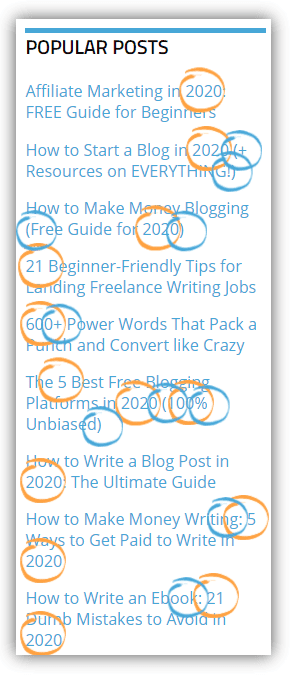
Each catchy and effective headline includes at least one of the following:
- a punctuation mark, specifically a colon or parentheses
- a percentage symbol
- numbers, sometimes signifying the current year
Coincidence? Hardly.
CTR Boosters Turn Good Headlines into Great Headlines
Clearly, these posts are popular because their content is awesome. But, their symbol-and-number-riddled headlines are also helping to boost their popularity. They’re sporting that oh-so-charming brain candy that encourages open rates, reads, and social media shares.
You might know this brain candy as click-through rate boosters.
(These click-through rate boosters work great in tweets and email subject lines, too, by the way.)
But let’s back up for a moment. What is a headline click-through rate, and why does it matter?
The vital role our headlines play in attracting and engaging our readers was expressed by David Ogilvy, the “Father of Advertising”:
“On the average, five times as many people read the headline as read the body copy. When you have written your headline, you have spent eighty cents out of your dollar.”
In the digital marketing world, click-through rates (CTRs) are used to measure the effectiveness of an advertisement. Simply, it’s that vital ratio of people who’ve clicked on an ad to the number of times the ad is shown.
Similarly, Google — in addition to other metrics like dwell time and bounce rate — uses headline conversion rates from search engine result pages (SERPs) to measure a post’s success in satisfying search intent.
Higher CTRs, which indicate the effectiveness of attracting and engaging targeted traffic, may raise a post’s relative SEO ranking.
In short: CTR boosters can help you get more clicks, which will compel Google to rank your content higher in search results.
Is This Jedi-Mind-Trickery Considered Cheating?
Worse yet, is it “clickbait” (like you might find on BuzzFeed or Upworthy)?
The Urban Dictionary sums up clickbait (negatively) as:
“a link which entices you to click on it. The “bait”… is usually intentionally misleading… Clicking will inevitably cause disappointment…”
But Copyblogger’s Stephanie Flaxman states:
“If your content delivers on your headline’s promise, it’s not clickbait. Period.”
The takeaway?
Crafting a compelling, click-worthy headline isn’t “clickbait” if your content delivers on the promise made in the headline. So, don’t be afraid to make your headlines enticing — that’s their job, after all.
Numbers in Headlines Bonus Tip:
Good headline CTR boosters are seemingly trivial numbers, symbols, or punctuation in headlines that grab the primal curiosity of potential readers and draw them in. Combine them with compelling number psychology tactics, and you’ll shine a spotlight on your headlines.
Use Numbers to Ramp Up Headline Conversion Rates
SEO-friendly, compelling headlines are tough to write, aren’t they?
Number psychology isn’t an exact science, and neither is great headline writing. But, strategically implementing what you’ve just learned will make your headlines more compelling. Decades of marketing data say so.
So…
Want to take your headline writing game to the next level? Want to write better headlines that grab the reader’s attention (and, by extension, the attention of search engines), stop them in their tracks, and compel them to click?
Then you need to shamelessly borrow moves from the number psychology playbook.
You got this!
The post Write Headlines That Convert: 10 “Number Psychology” Tips! appeared first on Smart Blogger.
from
https://smartblogger.com/how-to-write-a-headline-that-converts/
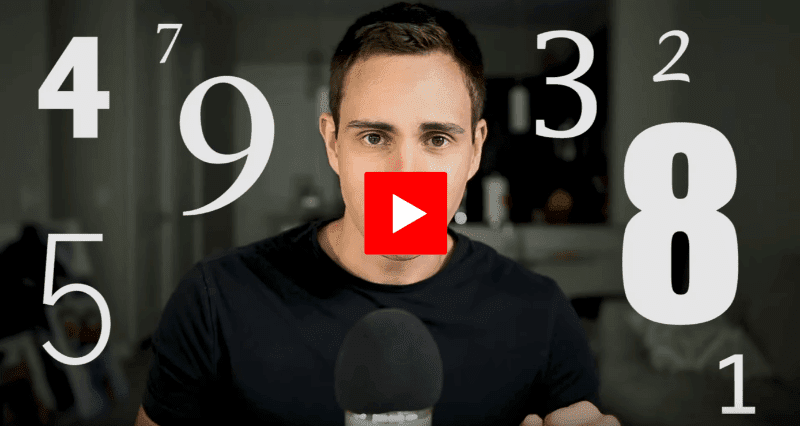
No comments:
Post a Comment